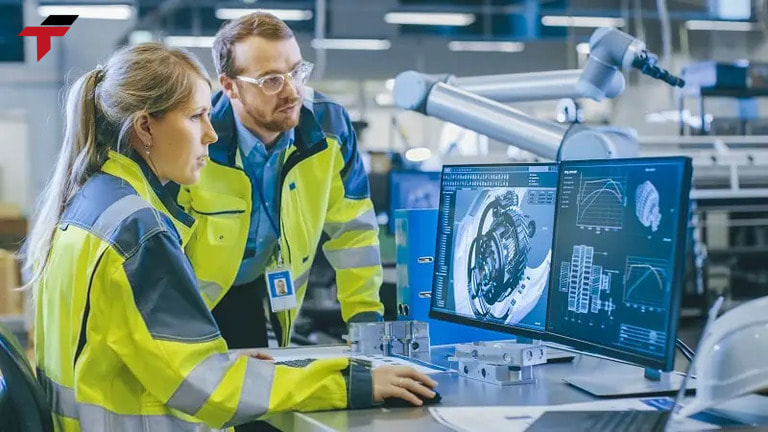In modern manufacturing environments, the combination of humans and machines plays an important role in ensuring performance and safety. Human Factors Engineering (HFE) is the solution to optimize the interaction between humans and systems, thereby improving productivity, minimizing operating errors and enhancing work experience. So what is HFE? How is it applied in automation? Let’s find out the details with FLEXTECH in the article below.
What is the Human Factors Engineering?
Human Factors Engineering (HFE) in automation is a field of study and application of principles of psychology, physiology and engineering to optimize the interaction between humans and automated systems.
The goal of HFE is to design systems, devices and processes that are compatible with human capabilities, limitations and behaviours, thereby improving performance, safety and user experience.

What is the Human Factors Engineering?
What are the three main goals of Human Factors Engineering?
- Enhance system performance: By designing a friendly, intuitive interface and a streamlined operating process, HFE reduces operating time, speeds up work processing, and improves accuracy. This not only improves overall productivity but also minimizes human errors.
- Improve safety and reduce risks: Workplace safety is one of the most important factors in HFE, especially when people work in highly automated environments. Designing the system with clear warning mechanisms, easy controls, and safe operating procedures helps minimize the risk of accidents.
- Improve user experience and comfort: By designing a work environment that is suitable for people’s physical and cognitive abilities, HFE reduces stress and fatigue during work.
In the context of increasingly developing automation, integrating HFE into system design not only helps improve operational quality but also contributes to building a sustainable and safe working environment for people.
What are the disadvantages of Human Factors Engineering?
Although Human Factors Engineering (HFE) offers many benefits in optimizing performance, safety and user experience, it also has some limitations and challenges when applied in practice.
- High initial investment costs: Integrating HFE into a production system requires businesses to invest in research, redesign processes, purchase new equipment or upgrade existing systems. This can create financial pressure, especially for small and medium-sized enterprises (SMEs).
- Time-consuming implementation: HFE cannot be applied immediately but requires time for research, testing and adjustment.
- Not always as effective as expected: Although HFE is designed to optimize the interaction between humans and systems, in some cases, unforeseen factors such as user psychology, work habits or environmental conditions can affect the actual effectiveness.
- Need to train quality human resources: HFE is a field that requires high expertise, but not every business has a team of experts in this field.

What are the disadvantages of Human Factors Engineering?
What is the application of Human Factors Engineering in automation?
Human-Machine Interface (HMI) Design
Human Factors Engineering (HFE) helps create intuitive, easy-to-understand control interfaces that make it easy for operators to monitor and control the system.
Elements such as colors, layouts, fonts, charts, and alerts are all designed to minimize errors and improve user response speed.
Optimizing factory layout and production lines
Arranging machines, equipment, and work areas according to HFE principles helps reduce redundant operations, optimize workflows, and increase productivity.
This is especially important in highly automated manufacturing plants where humans and machines must work closely together to ensure operational efficiency.
Improve the working environment
HFE helps adjust environmental factors such as light, noise, temperature and humidity to suit human working capacity.
A scientifically designed working environment not only helps increase productivity but also reduces fatigue, stress and work-related health problems.
Support employee training and coaching
HFE helps design friendly, accessible training programs, helping employees quickly get acquainted with new technology. The use of virtual reality (VR), augmented reality (AR) simulations or smart training interfaces helps improve learning efficiency, reduce training time and limit errors in actual operation.
Applying Human Factors Engineering in automation not only helps optimize the system but also ensures safety and comfort for workers, creating an efficient and sustainable working environment.

What is the application of Human Factors Engineering in automation?
What are the things to consider when integrating Human Factors Engineering into a business?
Applying human factors engineering (HFE) is not simply about improving the system design; it also requires an implementation strategy suitable for each business’s characteristics.
To effectively apply Human Factors Engineering (HFE), businesses need to have a suitable strategy, avoid wasting resources and ensure an optimal system. Below are important factors to consider when implementing:
- Analyze the actual needs of the business: Before applying HFE, businesses need to assess the current working environment, identify outstanding issues and clearly understand the needs of employees.
- Training and raising awareness for employees: Proper training, providing easy-to-understand instructions and organizing practical training sessions help employees quickly access and minimize errors during operation.
- Continuous Evaluation and Improvement: HFE is not a fixed solution but needs to be evaluated and adjusted regularly to meet changes in technology, production processes and worker requirements.
- Consider long-term costs and benefits: HFE implementation can require high initial investment costs, from system upgrades, and employee training to production process changes.

What are the precautions when using Human Factors Engineering?
Conclusion
Human Factors Engineering (HFE) plays an important role in optimizing the interaction between humans and automated systems, helping to improve performance, ensure safety and improve user experience.
Integrating HFE into businesses not only helps to minimize errors, increase productivity but also creates a friendly and sustainable working environment.
Although there are many challenges in the implementation process, with the right investment and appropriate strategy, HFE will bring long-term benefits, contributing to promoting business development in the automation era.
